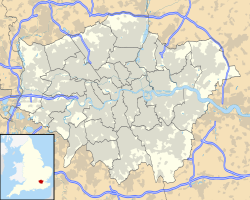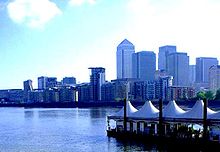Surrey Commercial Docks
Location of the Surrey Commercial Docks in Greater London |

The Surrey Commercial Docks were a large port facility in Rotherhithe (London) on the south bank of the Thames . The docks were in use in one form or another from 1696 to 1969. Most of them were then backfilled and houses were built on them. The area is now called Surrey Quays , but there is also the name Surrey Docks .
history
The thinly populated Rotherhithe peninsula was originally wet marshland along the river. It was unsuitable for agricultural use, but its location on the Thames, just below central London, made it an ideal location for port facilities. The area has long been associated with shipping activities: in June 1620, the Pilgrim Fathers ' ship , the Mayflower , set off from Rotherhithe for Southampton and was equipped with food and other goods for the crossing to New England , and an important Royal Navy shipyard was just downriver Deptford . In 1696 the Howland Great Wet Dock (named after the landowner's family) was built, the largest port basin in the world at the time, which could accommodate 120 sailing ships.
In the middle of the 18th century the harbor basin had become the base of operations for whalers in the Arctic and was therefore renamed Greenland Dock (Greenland harbor basin). In the 19th century, the increase in traffic from the Baltic States and Scandinavia (mainly wood), as well as Canada (food for the London population) led to the expansion of the Greenland Dock and the construction of additional docks to accommodate an increasing number of ships. After all, 85% of the peninsula's land area, an area of 1.9 km², was covered with a system of nine docks, six wooden pools and a canal. Many of the docks were named after the origin of their customers, e.g. B. Canada Dock , Quebec Pond , Norway Dock and Russia Dock . The Grand Surrey Canal opened in 1807, connecting the docks with facilities farther from the Thames, but it proved to be an economic disaster and only 3.5 miles were ever built.
A certain way of working established itself in the docks, which differed significantly from that of the Isle of Dogs on the other side of the river. A typical sight of these docks were the "wooden girders", dock workers who had specialized in carrying large quantities of cut wood on their shoulders and who wore special headgear that protected their heads from the raw wood.
The decline of the port facilities began in World War II when they were badly damaged in German air raids. The South Dock was pumped out and used to build the concrete caissons from which the Mulberry ports were assembled for D-Day . With the advent of container ships, however, the port basins became too small. They were finally closed in 1969 due to a lack of demand. The Grand Surrey Canal was closed, emptied and backfilled in 1971. For more than a decade the site became an industrial wasteland, the warehouses were demolished and over 90% of the port facilities were filled. The only remaining free water bodies are the Greenland Dock, the South Dock, parts of the Canada Dock (now called Canada Water ), the Norway Dock and a basin called Surrey Water . In 1981 the Conservative government under Margaret Thatcher founded the London Docklands Development Corporation (LDDC), which was to take over the urban development of the former port facilities east of central London - including the Surrey Docks.
The area today
In the 1980s and early 1990s, the Surrey Docks site was thoroughly modernized and renamed Surrey Quays . Over 5,500 new residential units were built, from terraced houses to apartments in one large apartment block. The South Dock was converted into a marina - now the largest in London - and a water sports center was built at Greenland Dock. Canada Water and the filled Russia Dock became nature reserves; a forest was formed on the latter. Leisure facilities were also built and light industry settled, e.g. B. The new printing house of Associated Newspapers , publisher of London's Evening Standard and Daily Mail newspapers .
In October 1988, the Surrey Quays Shopping Center opened as the newly developed center of the property. The nearby London Overground station was renamed Surrey Quays a few months later . Fisher Athletic FC football club is based at the Surrey Docks.
Web links
Individual evidence
- ↑ www.mayflower.com Route and maps of the journey of the Mayflower ( Memento of the original from December 29, 2010 in the Internet Archive ) Info: The archive link was automatically inserted and not yet checked. Please check the original and archive link according to the instructions and then remove this notice.
- ↑ The Grand Surrey Canal at Londoncanals.co.uk (English) ( Memento of the original from March 31, 2010 in the Internet Archive ) Info: The archive link was automatically inserted and not yet checked. Please check the original and archive link according to the instructions and then remove this notice.



